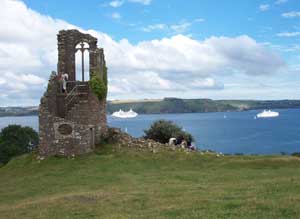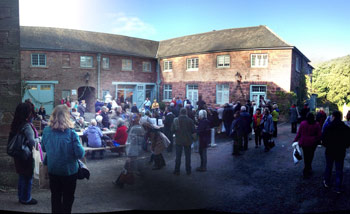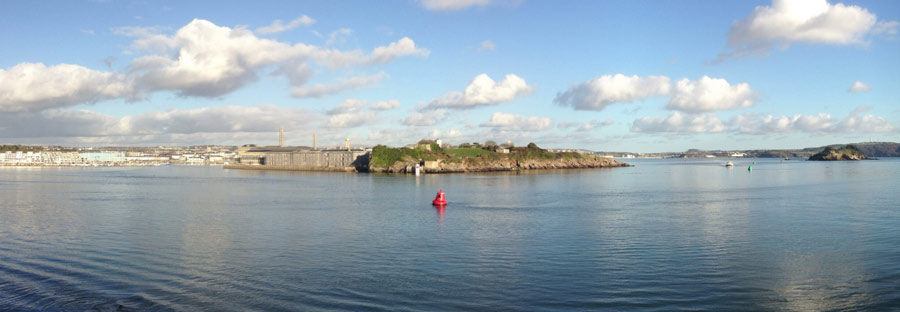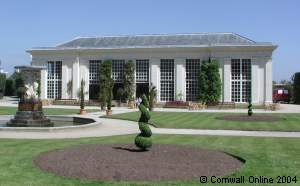Mount Edgcumbe House and Country Park in Cornwall

Cornwall Online | Looe | Rame Peninsula | Kingsand | Cawsand | Mount Edgecumbe Country Park | Torpoint | Antony House NT | St Germans | Saltash | Plymouth
 |
 |
 |
MOUNT EDGCUMBE HOUSE & COUNTRY PARK
Magnificent House in a picturesque riverside location.
Mount Edgcumbe is a stunning Tudor home of the Earls of Mount Edgcumbe. The house is located on a peninsula that extends into the River Tamar, giving Edgcumbe and the surrounding grounds some spectacular views over Plymouth Sound, one of England's finest natural harbours.
In the early-16th century the estate, along with the adjacent Rame peninsular came into the possession of Sir Piers Edgcumbe, through marriage. Sir Piers' family home was located ten miles to the north of the Rame peninsula, on the banks of the River Tamar at Cotehele. Sir Piers created a deer park at Mount Edgcumbe in 1539. The first family residence was started by Richard Edgcumbe (the son of Sir Piers) who in 1547, commissioned Roger Palmer, a local mason, to build a new house on the eastern slopes of the peninsula, overlooking Plymouth Sound and the River Tamar.
The Edgcumbe family eventually moved their household from Cotehele to Mount Edgcumbe during the late 17th century. In the 18th and early-19th century the Edgcumbe's undertook a large scale remodelling of the interior decor house and some external rebuilding.
The corner towers were re-stylised into the current octagonal form by Richard, 1st Lord Edgcumbe, in 1749. The grounds at Mount Edgcumbe were transformed into one of the finest landscape gardens in England, by Richard's son, an admiral in the fleet, who became 1st Earl of Mount Edgcumbe in 1789. The 1st Earl and his son between them created Cornwall's earliest landscaped park. The Grade I listed gardens survive largely unchanged - providing a stunning park land environment on the banks of the Tamar.
In the Second World War, the house was destroyed by German bombers during the 1941, Blitz on Plymouth. The house was left as a derelict shell until 1958, when Adrian Gilbert Scott was commissioned by the 6th Earl to rebuild the house using a steel frame and concrete floors. The house and the 865 acres of grounds were jointly purchased by Plymouth City Council and Cornwall County Council in 1971. The magnificent grounds and gardens were turned into a country park.
Parking is either in the grounds near the Deer Park, or adjacent to the River near the village of Cremyl. A passenger ferry runs from the village across the river to Plymouth. From the gates at Cremyll a wide avenue leads up to the house, high on the hillside. Trees line the avenue, creating a magnificent vista. Fetes are regularly held on the avenue.
After World War II the rendering was removed from the walls which now show as red sandstone with granite dressings. The external details mostly date from the early 19th century but the entrance at the centre of the north front has its original mid-16th century doorway surrounded by late-17th century Doric pilasters and a pediment.

The Waterfront at Mount Edgcumbe House - looking across the River Tamer towards Plymouth Drakes sland
|
||
 |
||
|
The Orangery at Mount Edgcumbe |
||
 |
Mount Edgcumbe is rare among English country houses because of its post-War interior design. The comfortable house is decorated in neo-Georgian style. Much of the Edgcumbe family's collection of paintings and furniture were destroyed in the fire and, although the current owners are refurnishing the building, several of the rooms still have an empty feel. The Hall is the most impressive room and was rebuilt by Scott to provide a splendid staircase at the east end with a gallery on the first-floor. The Drawing Room, overlooking the 19th century garden, has a Boulle desk, a portrait of the 2nd Lord Edgcumbe by Reynolds and two Van de Velde seascapes.
In the Library is a 19th century painting of a tenants' dinner in the hall at Cotehele. The Dining Room has two 16th century Flemish tapestries with hunting scenes also brought from Cotehele. On the first floor are a number of comfortable bedrooms and bathrooms and a tiny chapel commemorating the 6th Earl's only son who was killed in the War.
Properties in Torpoint

Self catering
Bucklawren is a collection of holiday cottages sleeping 2 to 8 people set an idealllocation, close to the beaches - ideal for exploring Cornwall and west Devon, with their many attractions. There is golf, cycling, riding, tennis and water sports all available close by and also the safe bathing beaches of Millendreath, Seaton and Looe. Luxury holiday cottages sleeping 2, 4 , 6 and 8 people |
|

Bed & Breakfast
Six en-suite luxury bedrooms with sea and rural views, Set in an exceptional peaceful location Bucklawren Bed and Breakfast has a large spacious lounge to relax, and all bedrooms are equipped with tea and coffee facilities, fridges, TVís and hairdryers. All you need for a relaxing stay. Sleeps 12 + |
|

Self catering Holiday Bungalow
A delightful self-catering Holiday Home located on a corner plot with open views over Looe and the Looe River. River View Holiday Bungalow is ideal for families or groups looking for a comfortable and conveniently located base to explore Looe and South East Cornwall and enjoy a relaxing getaway.Located near the coast, with easy to access Looe's sandy beaches, the picturesque fishing harbour, and various coastal paths. It is also close to local amenities and attractions, such as shops, restaurants, pubs, and gives easy acces to the local fishing village of Polperro and Fowey.The Holiday Offers spacious living areas with comfortable furnishings and a balcony with scenic views. Sleeps 6 people in three Bedrooms. |
|
 |
|
Promoting
your business on Cornwall Online |
|
Cornwall
Online is a trading name of ITS WEB DESIGN - COL DIRECT
Cornwall Online Website by ITS WEB DESIGN - COL DIRECT. Tel 01579 557343 Please ensure that you confirm all details with the Advertiser before Booking We recommend that you take out Holiday Insurance on ALL Bookings |